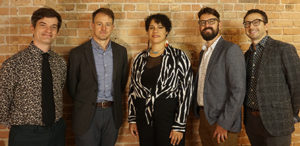Third Coast Percussion plays Stanford’s Bing Concert Hall, May 7, 2025
Witnessing the Third Coast Percussion’s performance was a delight. The four musician-magicians, Sean Connors, Robert Dillon, Peter Martin, David Skidmore, play at a very high level. They demonstrate the serious art that they enjoy in collaboration with other artists. The Bing Concert audience was thrilled with creations by four composers and guest violin artist, Jessie Montgomery, who was also one of the composers.
The program opened with Please Be Still, by Jlin (2024). Third Coast Percussion commissioned the work to celebrate their 20th anniversary. It was a good way to get a listener’s head into the world of rhythm. The musicians each, mostly, addressed different percussion instruments. They would walk around the collection of Things that make sounds out of soft bumps or sliding strokes and choose the marimba, look at it, and after a few nods or gestures in air by drum sticks (with large, soft looking heads) enter the particular rhythms’ realm. Composer Jlin reveals her inspiration for Please Be Still:
“When they asked me to compose a piece that was Bach-based I, of course, jumped right to it. The Bach piece I chose to derive from is “Kyrie Eleison,” the movement from Bach’s “Mass in B Minor.” That piece has so many rhythmic sections with endless possibilities. I’ve been a lover of Bach’s music since I was a kid, and always found his work complicated. The percussionist in me hears Bach’s keystrokes as if they were individual acoustic drums. I’m always trying to play against the rhythm, and this piece was not different.”
 Musicians of TCP with Jessie Montgomery; the Third Coast is Chicago, of course.
Musicians of TCP with Jessie Montgomery; the Third Coast is Chicago, of course.
Jessie Montgomery’s work, Lady Justice/Black Justice/The Song (2024) was powerful.The work does not hide what it expresses. A statue of “Lady Justice,” by Ori G. Carino inspired the composer; the Lady is a fount of Justice in a world of injustice, specifically toward Black people. The statue and a painting had been in a room with light cast through its layering of silk. As the composer wrote: “the silk layering, revealing her timelessness and multiple hues. The image is staggering, aspirational, and technically virtuosic.” Montgomery found deep feelings which met visual representations and turned that reality into music. It is a successful work of artistic alchemy. She salutes “Ori’s natural sense of beauty and grit,” which led her into ideas that spun textures, light, and “emotional qualities” into this major work. Collaboration can happen when the collaborator is not available for meetings. “The main melody that appears throughout (which harkens to a Brahms-inspired theme that I wrote years ago, inspired by a line in Langston Hughes’ epic poem, “Ask Your Mama: 12 Moods for Jazz.”)
I was pleased to experience this new music. When I began to dance and choreograph full time, rhythm was taboo. Anything Brahms was simply dead. I had read Langston Hughes in 8th grade and loved every line. A lot of people who could read, did not read or know about Hughes. I went ahead with rhythms because how else could I dance?
Tigran Hamasyan’s Sonata for Percussion (2024) is in sonata form of three movements. It could be fast, slow, fast, but those fast times are not identical. TCP found the piece required techniques not in their vocabulary. Hamasyan’s band plays exciting and challenging rhythms. It took TCP on a wild hike in hills, turning while moving forward. “The outer movements both explore different subdivisions of 23-beat rhythmic cycles, while the middle movement is in a (relatively) tame seven.” The movements have meaningful titles although there is no story: Memories from Childhood, Hymn, 23 for TCP.
Jessie Montgomery’s Suite from In Color has history. When working with TCP for her first foray in a percussion ensemble, she brought “excerpts from a number of existing works.” In Color was one of them. She used this exploration to develop musical sounds. The work she did make was different than what the original explorations would have made. Sean Connors, of the TCP, asked to arrange what they had been doing and made it a percussion quartet. It has a unique approach for the items making the sounds into “Red, The Poet, Purple” movements.
The program ended with Lou Harrison’s Concerto for Violin and Percussion Orchestra (1940/1959). The program says “Lou Harrison holds a particularly special place in the heart of percussionists.” Harrison and John Cage were among the earliest composers of classical style to write for percussion ensembles. Harrison also holds a special place in the SF Bay Area music world. He was a warm and welcoming human. While Cage avoided harmony or melody, Lou made Things and instruments sing when he tapped, knocked, or even slapped them. He made non-pitched items musical and helped Things get along with other instruments. In this performance the audience was able to see a full range of percussion music. Physical movement of the percussionists added theater to the program. Flower pots and other objects joined the orchestra. Harrison’s movement for the solo violin allowed us to hear the full range of Montgomery as violinist as well as composer. The audience jumped to applaud TCP and Montgomery.
Photo courtesy of Stanford Live. Quotations from composers courtesy of Stanford Live program book.